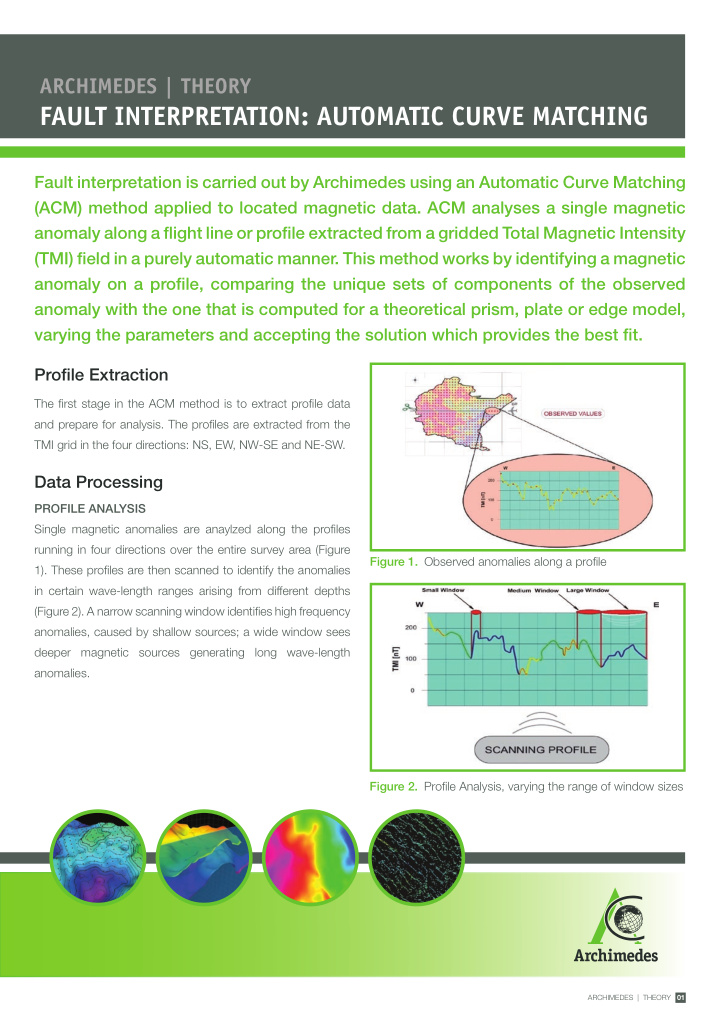



ARCHIMEDES|THEORY 01 ARCHIMEDES | THEORY FAULT INTERPRETATION: AUTOMATIC CURVE MATCHING Fault interpretation is carried out by Archimedes using an Automatic Curve Matching (ACM) method applied to located magnetic data. ACM analyses a single magnetic anomaly along a flight line or profile extracted from a gridded Total Magnetic Intensity (TMI) field in a purely automatic manner. This method works by identifying a magnetic anomaly on a profile, comparing the unique sets of components of the observed anomaly with the one that is computed for a theoretical prism, plate or edge model, varying the parameters and accepting the solution which provides the best fit. Profile Extraction The first stage in the ACM method is to extract profile data and prepare for analysis. The profiles are extracted from the TMI grid in the four directions: NS, EW, NW-SE and NE-SW. Data Processing PROFILE ANALYSIS Single magnetic anomalies are anaylzed along the profiles running in four directions over the entire survey area (Figure Figure 1. Observed anomalies along a profile 1). These profiles are then scanned to identify the anomalies in certain wave-length ranges arising from different depths (Figure 2). A narrow scanning window identifies high frequency anomalies, caused by shallow sources; a wide window sees deeper magnetic sources generating long wave-length anomalies. Figure 2. Profile Analysis, varying the range of window sizes
02 • Aplateorthinsheetbodywherethe • Anedgeorcontactmodel(Figure5); • A dyke-like body where the depth fjt and high confjdence results. By taking this approach a anomalyisknownas‘curvematching’(Figure6).Stringent bulk volume of the concentration of ARCHIMEDES | THEORY FAULT INTERPRETATION: AUTOMATIC CURVE MATCHING Data Processing continued A series of theoretical models with different parameters OBSERVED DATA AND MODEL DATA CORRELATION capturing the variation in shape, size and magnetisation of Each single anomaly (observed and theoretical) can be potential magnetic bodies is prepared. represented by vertical and horizontal components, which can be further split into symmetrical and asymmetrical functions. Three main models are used: Therefore one anomaly is represented by a unique set of four functions. The process of comparing such a set of functions extent is much greater than the depth representing the observed anomaly with the theoretical to the top of the body (Figure 34); this could be used to approximate the similarity coefficient cut-offs (a measure of the goodness of fit of the four matched functions) are used to ensure best Fig 3. magnetized material. unique solution showing: depth, width, dip and magnetic depth extent is much less than the susceptibility of the causative body is obtained. depth to the top of the body (Figure 4); this could be used to approximate Fig 4. sedimentary horizons, and this could be used to approximate geological contacts. Fig 5. The observed data and profiles are extracted from grids of the TMI field and are then scanned with a range of window sizes Figure 6. Curve matching of four components from designed to detect anomalies arising from different depths. observed and theoretical data.
ARCHIMEDES|THEORY 03 The3Dvolumecanthenbetakenintoaworkstationwhere thecontrastinmagneticsusceptibilityoftherocksoneither sideofthefaultplane.Thesefactorscanmakeidentifjcation and‘dots’displayedin3D OUTPUT DATA The ACM technique computes depth, susceptibility, and geometry of the causative body, as well as a similarity coefficient. This is repeated for each model and in each profile direction (Figure 7). The results obtained are then combined into a 3D data volume (Figure 8 the visualisation tools can be used to interpret lineaments and Figure 7. Depth profiles produced by curve matching potential faults. FAULT INTERPRETATION The results are further analysed to identify the most statistically significant results, which are visualized in 3D. Manual interpretation is carried out, generally in the planar view of successive depth intervals panelling through the volume of the data (Figure 10). The lineaments at multiple depths can be joined vertically, that allows identification of the large scale faults in 3D. By examining various combinations of Fig 8a the theoretical models, as well as different directions of the profiles, structures within the sediments and the underlying basement are interpreted (Figure 9). The ability to identify faults can be affected by several factors including the extent of magnetization along the fault plane and of both non-mineralised and mineralised faults possible. When the ACM results from all the profile directions supports Fig 8b (b) the presence of a fault, and the lineaments can be correlated Figure 8. a ‘Dots’andsurfacesdisplayedin3D laterally and at depth, a fault plane can be gridded in 3D b Lineament interpretation along with surfaces (Figure 10).
04 ARCHIMEDES|THEORY aredeliveredinworkstationreadyformatsforintegrationwithothergeosciencedata.Ourproprietarytechniquesextractthe ARCHIMEDES | THEORY FAULT INTERPRETATION: AUTOMATIC CURVE MATCHING Figure 9. Identification and interpretation of magnetic Figure 10. Lineaments observed at different depths and lineaments. interpreted as faults. Summary Archimedes approach to the interpretation of high resolution aeromagnetic data allows the detection in 3D of faults, associated structures and even fracture patterns within different sedimentary formations, as well as the underlying basement. Results maximum information and deliver a detailed interpretation to aid in further exploration and development.
Recommend
More recommend